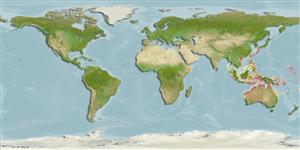Common names from other countries
>
Siluriformes (Catfishes) >
Plotosidae (Eeltail catfishes)
Etymology: Paraplotosus: Greek, para = in the side of + Greek, plotos = swimming (Ref. 45335); butleri: Named in honor of W. 'Harry' Butler, who assisted in with the collection of many of the paratypes (Ref. 31103).
Environment: milieu / climate zone / depth range / distribution range
Ecologia
marinhas associadas(os) a recifes; intervalo de profundidade 0 - 5 m (Ref. 31103). Tropical
Indo-West Pacific: northern Australia.
Tamanho / Peso / Idade
Maturity: Lm ? range ? - ? cm
Max length : 32.5 cm SL macho/indeterminado; (Ref. 31103)
Descrição suscinta
Morfologia | Morfometria
Espinhos dorsais (total): 1; Raios dorsais (total): 115-130; Espinhos anais 0; Raios anais : 87 - 102. Differs from Paraplotosus albilabris and P. muelleri in having a tall, sail-like first dorsal fin and extremely long nasal barbels, which extend posteriorly to the basal third of the pectoral fin or beyond (Ref. 31103). Small juveniles have a unique coloration consisting of a black head and body with a broad white to yellow margin on the first dorsal fin and continuous dorsal-caudal-anal fin (Ref. 31103). Adults entirely black (Ref. 31103).
Restricted to coastal reefs (Ref. 31103). Secretive, found in reef holes or under large rocks (Ref. 31103). Presumably nocturnal (Ref. 31103). Feeds on gastropod mollusks and crustaceans (Ref. 31103).
Ciclo de vida ou comportamento de acasalamento
Maturidade | Reprodução | Desova | Ovos | Fecundidade | Larvas
Allen, G.R., 1998. A review of the marine catfish genus Paraplotosus (Plotosidae) with the description of a new species from north-western Australia. Raf. Bull. Zool. 46(1):123-134. (Ref. 31103)
Status na Lista Vermelha da UICN (Ref. 130435)
CITES (Ref. 128078)
Not Evaluated
Ameaça para os humanos
Harmless
Uso pelos humanos
Mais informação
Nomes comunsSinônimosMetabolismoPredadoresEcotoxicologiaReproduçãoMaturidadeDesovaFecundidadeOvosDesenvolvimento dos ovos
Idade/TamanhoCrescimentoPeso-comprimentoComprimento-comprimentoFrequências de comprimentoMorfometriaMorfologiaLarvasDinâmica larvalRecrutamentoAbundância
ReferênciasAquaculturaPerfil para aquaculturaEstirpesGenéticaElectrophoresesHereditariedadeDoençasProcessamentoConversão de massa
ColaboradoresFotosStamps, Coins Misc.SonsCiguateraVelocidadeTipo de nataçãoÁrea branquialOtólitosCérebrosVisão
Ferramentas
Relatórios especiais
Baixar XML
Fontes da internet
Estimates based on models
Preferred temperature (Ref.
115969): 24.4 - 29.2, mean 28.3 (based on 1313 cells).
Índice de diversidade filogenética (Ref.
82804): PD
50 = 0.6250 [Uniqueness, from 0.5 = low to 2.0 = high].
Bayesian length-weight: a=0.00457 (0.00199 - 0.01049), b=3.07 (2.86 - 3.28), in cm Total Length, based on LWR estimates for this (Sub)family-body shape (Ref.
93245).
Nível Trófico (Ref.
69278): 3.4 ±0.54 se; based on food items.
Resiliência (Ref.
120179): Elevada, tempo mínimo de duplicação da população menor que 15 meses (Preliminary K or Fecundity.).
Fishing Vulnerability (Ref.
59153): Low to moderate vulnerability (30 of 100).
